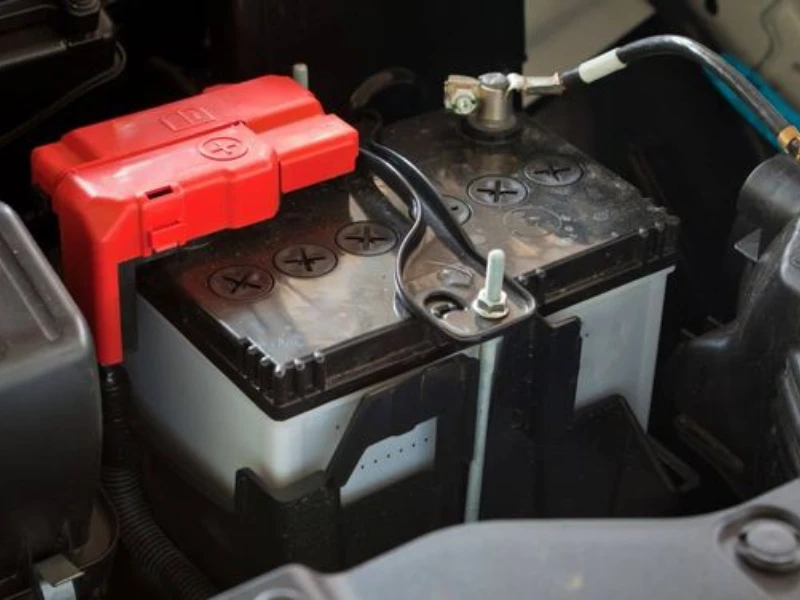Battery acid, often known as an electrolyte, plays an essential role in battery operations, particularly in lead-acid batteries. This electrolyte is primarily composed of sulfuric acid (H2SO4) diluted in distilled water. The solution formed is a crucial factor determining the battery’s lifespan, performance, and safety. Comprehending the complexity and nature of acidity in battery acid, as indicated by its pH level, is crucial for maintaining an efficient energy system for automotive and industrial applications. A well-maintained pH level ensures the peak performance of the battery while safeguarding its longevity.

The Chemistry Behind Battery Acid
Battery acid primarily comprises a diluted solution of sulfuric acid in water. Sulfuric acid, a robust and highly corrosive compound, disintegrates into hydrogen ions (H+) and sulfate ions (SO4^-2) in an aqueous solution (aq). The ‘mol,’ or molar concentration of the electrolyte, plays an essential role in the battery’s energy production and storage processes. The critical process involved is the flux of ions between the electrodes, creating usable electric energy.
The chemical formula for this dissociation is as follows: H2SO4(aq) → 2H+(aq) + SO4^-2(aq). The ions formed during this process contribute to the overall conductivity of battery acid. This ion exchange enables the battery to generate and store electricity, making it a vital aspect of battery operation.
PH Scales and Their Significance
The pH scale measures the acidity or alkalinity of a solution, ranging from 0 to 14. Seven is neutral, values below 7 denote an acidic solution, and those above 7 are alkaline. Every unit shift on the pH scale represents a tenfold change in acidity or alkalinity. Consequently, battery acid, with a typical pH value between 0 and 1, is classified as a potent or strong acid.
Understanding the pH scale is crucial because it provides insight into the battery acid’s reactivity. This information is essential for proper handling and usage of battery acids. The strong acidity of battery acid plays a vital role in the battery’s electrochemical reactions, which are necessary for its function.
The Specific PH of Battery Acid
The battery acid pH generally lies between 0 and 1. This distinct acidity is a prerequisite for a series of chemical reactions that convert stored chemical energy into usable electrical energy during power discharge. However, this function’s high degree of corrosiveness makes battery acid dangerous if improperly handled, leading to a heightened risk for severe burns upon accidental skin contact.
Comparative Acidic Strength and pH Levels:
| Acid | pH Level |
| Battery Acid (Sulfuric Acid) | 0 – 1 |
| Hydrochloric Acid (HCl) | 1 – 2 |
| Nitric Acid (HNO3) | < 1 |
The pH values for these common strong acids underscore the relative strength of battery acid. Battery acid’s low pH level makes it one of the most potent acids, reflecting its corrosiveness and the potential dangers associated with its mishandling.
How PH Level Affects Battery Performance
Most types of batteries, especially those involving sulfuric acid like lead-acid batteries, have their performance heavily influenced by their acidic pH level. The acidity enhances electrolyte conductivity, strengthens the chemical reaction involved in sulfate formation, and improves the energy conversion process. Any irregularity in the pH level could lead to reduced voltage output, decreased capacity, and an overall decline in performance. This highlights the importance of proper pH management.

Effect of Battery Acid Corrosion on Material Degradation
The low pH of battery acid, combined with its high chemical reactivity, creates a corrosive characteristic posing severe threats to materials in direct contact, typically lead and other metals used in the battery’s structure. The resulting corrosion, chemical burns, and potentially harmful gases not only impair battery performance but also present safety risks. Therefore, handling and regular maintenance should be carried out with utmost care.
The corrosion caused by battery acid can significantly affect battery performance. For instance, lead-acid batteries suffer from the formation of lead sulfate crystals on the electrodes, a process that reduces battery efficiency. Therefore, regular cleaning and maintenance are essential to minimize the effects of corrosion and to prolong battery life.
Safety Measures When Handling Battery Acid
Battery acid, due to its corrosive nature, requires careful handling. Wearing protective gear such as gloves, goggles, and clothing can help prevent unwanted chemical burns. In the event of accidental exposure, immediate rinsing with copious amounts of distilled water, followed by swift medical attention, is crucial. Moreover, storing well-ventilated areas away from easily ignitable substances is also necessary.
It’s crucial to follow safety guidelines when handling battery acid to avoid potential harm. This not only protects the person handling battery acid but also ensures that the battery remains undamaged and safe for use.
How to Adjust the PH Level of Battery Acid?
Preserving and potentially adjusting the ideal battery acid pH level requires changes in the ratio of sulfuric acid to distilled water. If the delicate pH balance falls too low, adding more distilled water can help restore a functional level. Conversely, if the pH turns out too high, introducing more sulfuric acid can cause a decrease. A higher pH does not necessarily signify potency; overly acidic mediums can damage the battery’s integrity.
The exact process for adjusting the pH of battery acid depends on the specific type of battery and should always be performed following the manufacturer’s guidelines. In all cases, it is necessary to exercise caution when performing such adjustments to avoid potential harm.
Effects of Environmental Conditions on Battery Acid PH
External factors like climate temperature, atmospheric humidity, and contamination levels can alter the battery acid’s pH level. Extreme temperature conditions can likely accelerate chemical reactions and, therefore, affect the pH level. Exposure to pollutants could also disrupt the sensitive pH balance, impacting the battery’s performance.
These environmental conditions can have a profound effect on the performance and lifespan of a battery. Therefore, it’s essential to store and use batteries in appropriate conditions to maintain their efficiency.

Methods of Determining the PH of Battery Acid
Several scientific measures can accurately determine the pH of battery acid. The usage of pH test strips, pH meters, and specific chemical indicators are common methods for pH measurement. These tools provide accurate readings that ensure precise evaluation and potential adjustments, thereby guaranteeing optimal battery performance.
It’s important to note that different methods for measuring pH may give slightly different readings. Therefore, it’s necessary to use a consistent method for monitoring battery acid pH over time to obtain reliable results.
PH Levels Comparison: Battery Acid vs. Other Common Acids
When compared with other prevalent strong acids, battery acid (pH of 0-1) exhibits higher acidity. Despite strong acids like hydrochloric acid (HCl) and nitric acid (HNO3) falling within the lower pH bands, battery acid surpasses them in acidity. Understanding this relative acidity offers perspective on the increased reactivity and corrosiveness of battery acid, which, unlike other acids, is found in many common appliances and vehicles.
This comparison highlights the unique characteristics of battery acid, especially in terms of its reactivity and potential for causing harm. As such, battery acid should be handled with the same caution as other strong acids, if not more so.
Related Article: Battery Acid Vs Distilled Water: A Detailed Comparison
Conclusion
Conclusively, the pH level in battery acid is a pivotal parameter that carries far-reaching impacts on performance, lifespan, and safety. Preserving the apt pH level enhances electrochemical reactions that potentially minimize the risk of material corrosion and degradation, thereby maximizing safety and battery lifespan. A comprehensive understanding of the importance of battery acid pH, along with the appropriate maintenance and safety measures, presents an opportunity to enhance the efficiency and reliability of batteries—a cornerstone for numerous modern applications.

